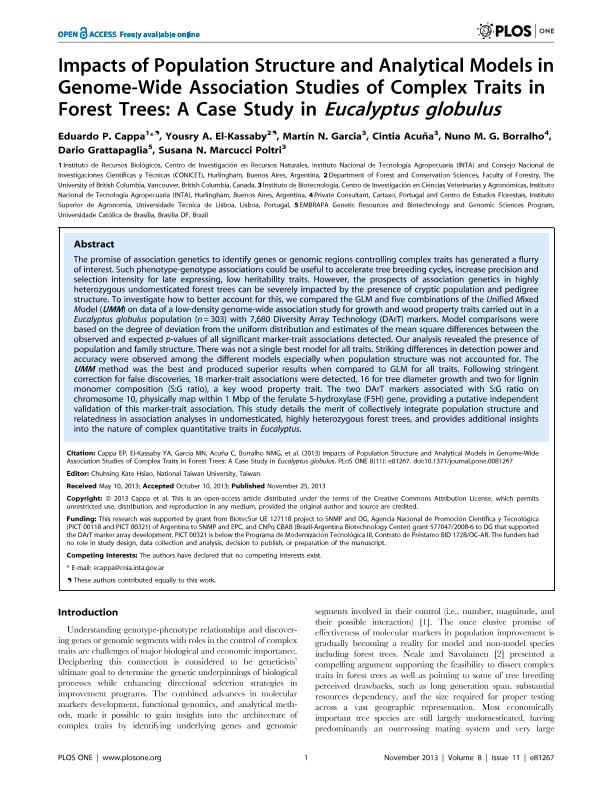Mostrar el registro sencillo del ítem
dc.contributor.author
Cappa, Eduardo Pablo

dc.contributor.author
El Kassaby, Yousry A.
dc.contributor.author
Garcia, Martín Nahuel

dc.contributor.author
Acuña, Cintia Vanesa

dc.contributor.author
Borralho, Nuno M. G.
dc.contributor.author
Grattapaglia, Dario
dc.contributor.author
Marcucci Poltri, Susana Noemí

dc.date.available
2017-09-08T19:10:52Z
dc.date.issued
2013-11
dc.identifier.citation
Cappa, Eduardo Pablo; El Kassaby, Yousry A.; Garcia, Martín Nahuel; Acuña, Cintia Vanesa; Borralho, Nuno M. G.; et al.; Impacts of population structure and analytical models in genome-wide association studies of complex traits in forest trees: a case study in Eucalyptus globulus; Public Library of Science; Plos One; 8; 11; 11-2013; 1-16; e81267
dc.identifier.issn
1932-6203
dc.identifier.uri
http://hdl.handle.net/11336/23864
dc.description.abstract
The promise of association genetics to identify genes or genomic regions controlling complex traits has generated a flurry of interest. Such phenotype-genotype associations could be useful to accelerate tree breeding cycles, increase precision and selection intensity for late expressing, low heritability traits. However, the prospects of association genetics in highly heterozygous undomesticated forest trees can be severely impacted by the presence of cryptic population and pedigree structure. To investigate how to better account for this, we compared the GLM and five combinations of the Unified Mixed Model (UMM) on data of a low-density genome-wide association study for growth and wood property traits carried out in a Eucalyptus globulus population (n = 303) with 7,680 Diversity Array Technology (DArT) markers. Model comparisons were based on the degree of deviation from the uniform distribution and estimates of the mean square differences between the observed and expected p-values of all significant marker-trait associations detected. Our analysis revealed the presence of population and family structure. There was not a single best model for all traits. Striking differences in detection power and accuracy were observed among the different models especially when population structure was not accounted for. The UMM method was the best and produced superior results when compared to GLM for all traits. Following stringent correction for false discoveries, 18 marker-trait associations were detected, 16 for tree diameter growth and two for lignin monomer composition (S∶G ratio), a key wood property trait. The two DArT markers associated with S∶G ratio on chromosome 10, physically map within 1 Mbp of the ferulate 5-hydroxylase (F5H) gene, providing a putative independent validation of this marker-trait association. This study details the merit of collectively integrate population structure and relatedness in association analyses in undomesticated, highly heterozygous forest trees, and provides additional insights into the nature of complex quantitative traits in Eucalyptus.
dc.format
application/pdf
dc.language.iso
eng
dc.publisher
Public Library of Science

dc.rights
info:eu-repo/semantics/openAccess
dc.rights.uri
https://creativecommons.org/licenses/by/2.5/ar/
dc.subject
Plant Genomics
dc.subject
Genome-Wide Association Studies
dc.subject
Complex Traits
dc.subject
Eucalyptus Globulus
dc.subject.classification
Ética relacionada con Biotecnología Agrícola

dc.subject.classification
Biotecnología Agropecuaria

dc.subject.classification
CIENCIAS AGRÍCOLAS

dc.subject.classification
Otras Agricultura, Silvicultura y Pesca

dc.subject.classification
Agricultura, Silvicultura y Pesca

dc.subject.classification
CIENCIAS AGRÍCOLAS

dc.title
Impacts of population structure and analytical models in genome-wide association studies of complex traits in forest trees: a case study in Eucalyptus globulus
dc.type
info:eu-repo/semantics/article
dc.type
info:ar-repo/semantics/artículo
dc.type
info:eu-repo/semantics/publishedVersion
dc.date.updated
2017-09-07T16:56:54Z
dc.journal.volume
8
dc.journal.number
11
dc.journal.pagination
1-16; e81267
dc.journal.pais
Estados Unidos

dc.journal.ciudad
San Francisco
dc.description.fil
Fil: Cappa, Eduardo Pablo. Instituto Nacional de Tecnología Agropecuaria. Centro de Investigación de Recursos Naturales. Instituto de Recursos Biológicos; Argentina. Consejo Nacional de Investigaciones Científicas y Técnicas; Argentina
dc.description.fil
Fil: El Kassaby, Yousry A.. University of British Columbia; Canadá
dc.description.fil
Fil: Garcia, Martín Nahuel. Instituto Nacional de Tecnología Agropecuaria. Centro de Investigación en Ciencias Veterinarias y Agronómicas. Instituto de Biotecnología; Argentina. Consejo Nacional de Investigaciones Científicas y Técnicas; Argentina
dc.description.fil
Fil: Acuña, Cintia Vanesa. Instituto Nacional de Tecnología Agropecuaria. Centro de Investigación en Ciencias Veterinarias y Agronómicas. Instituto de Biotecnología; Argentina. Consejo Nacional de Investigaciones Científicas y Técnicas; Argentina
dc.description.fil
Fil: Borralho, Nuno M. G.. Universidade Tecnica de Lisboa. Instituto Superior de Agronomia. Centro de Estudos Florestais; Portugal
dc.description.fil
Fil: Grattapaglia, Dario. Universidade Católica de Brasília; Brasil
dc.description.fil
Fil: Marcucci Poltri, Susana Noemí. Instituto Nacional de Tecnología Agropecuaria. Centro de Investigación en Ciencias Veterinarias y Agronómicas. Instituto de Biotecnología; Argentina. Consejo Nacional de Investigaciones Científicas y Técnicas; Argentina
dc.journal.title
Plos One

dc.relation.alternativeid
info:eu-repo/semantics/altIdentifier/url/http://journals.plos.org/plosone/article?id=10.1371/journal.pone.0081267
dc.relation.alternativeid
info:eu-repo/semantics/altIdentifier/doi/http://dx.doi.org/10.1371/journal.pone.0081267
Archivos asociados
